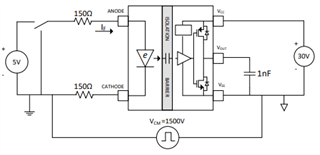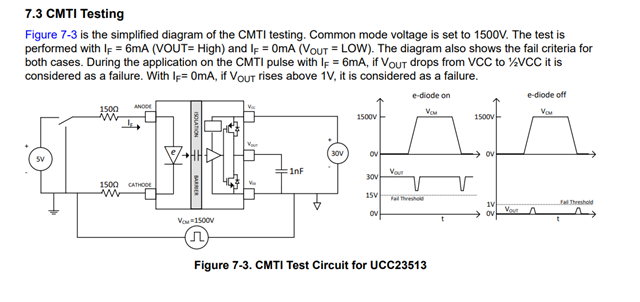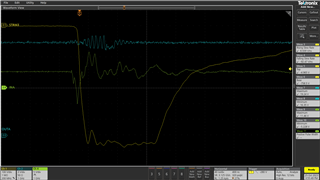Other Parts Discussed in Thread: STRIKE, , UCC21551, UCC21530
Hi Team,
just want to check how to achieve the Vcm in below CMTI test. My customer also want to test CMTI and want to check how we achieve this. Thanks.

BRs
Given
This thread has been locked.
If you have a related question, please click the "Ask a related question" button in the top right corner. The newly created question will be automatically linked to this question.
Hi Given,
Our expert is out of office due to Thanksgiving US holiday. We'll respond to you once they're back after the break which is 11/27/2023.
Best,
Pratik
Hi Given,
I wanted to follow up on your E2E post. In the UCC23513 datasheet we listed some of the testing conditions used. Please see below as well. Do you need guidance with the test bench set up? if so, what is your current set up?

Additionally, if you are currently working with a UCC23513EVM, I have included the user guide as well. UCC23513EVM
Kind regards,
Abbie
Hi Abble,
Thanks for your reply.
what I want to know is how we set up the 1500V Vcm. is it generated by a dedicated instrument or other method? Sorry for make you confused. Thanks.
Also, I want to know how the Vcm affect the device, that is, which parasitic routine that Vcm goes, does Vcm affect output logic ? Thanks.
BRs
Given
Hi Given,
We use an internal solution or dedicated instrument that utilizes a DC/DC converter to achieve the 1500V Vcm.
As long as the Vcm is within the datasheet spec of 1500V you should not see an affect on the output logic.
Kind regards,
Abbie
Yes it is a dedicated device. We use a Barth Model 731 3kV pulse generator and a Model 5081 Ramp Generator. It uses a high voltage coaxial cable. We charge it up to 2X the voltage required, and then close it into a matched impedance. This is also called a "pulse forming network", and the result is a relatively clean square wave pulse with a high power for a short duration. I have attached an example waveform.
As you can see, cross talk from the CMTI strike can couple into the input, and toggle the device erroneously. That is one of the reasons we recommend input capacitors and relatively low resistors between the uC and the gate driver input.
Best regards,
Sean
Hi Sean,
Thanks for your reply. so the " pulse forming network" is something like in below link, right?
CMTI-Test-System-Pg-1and2-Rev.-6-1-21A-1.pdf (barthelectronics.com)
And, based on your answer, the CMTI strike mainly affect Transmitter rather than Receiver in UCC23513, right?
I know there may be resistor between micro controller and input of gate driver which is gate resistor, what do you mean by input cap? Thanks.
BRs
Given
Yes, that link is exactly right. In my testing of UCC21530 and UCC21551 and similar competitor devices, the strike dragged down the input and that set the CMTI limit. I do know of a competitor device with a truly complimentary input that has 300V/ns, so I believe that this is a common issue.
The input capacitor will absorb the cross talk charge injection, and not allow the voltage to dip so rapidly. This will prevent a logic error.
The new photron device will have a 40ns minimum pulse limit, which should make it more immune to this type of CMTI noise.